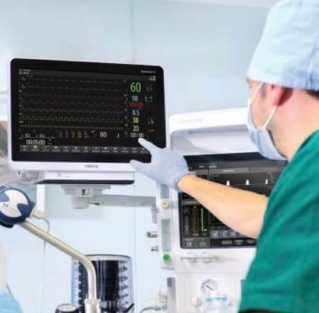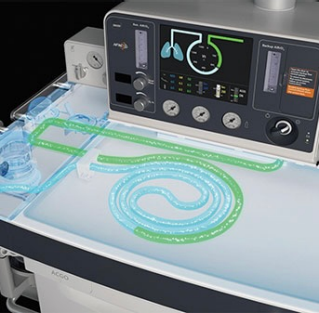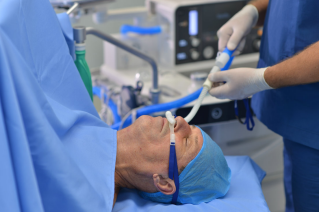Leveraging Low Flow Anesthesia to Advance Patient Safety and Environmental Sustainability
10-09-2024

However, patients only metabolize about 5% of administered anesthetic agents, with the remaining 95% vented to the outdoor atmosphere as waste.i
\r\n"}}" id="text-3d18ace297" class="8f00b2 cmp-text">Low flow anesthesia can help reduce the amount of anesthesia gas used while still providing safe and effective patient care that is better for the environment. The proper administration of anesthetics is essential to ensure patient safety and comfort during surgical procedures. General anesthesia is used to put patients in a sleep-like state and is commonly administered through a combination of intravenous medicines and inhaled gases.
However, patients only metabolize about 5% of administered anesthetic agents, with the remaining 95% vented to the outdoor atmosphere as waste.i
What is Low Flow Anesthesia?
Why Low Flow Anesthesia is Important
The benefits of low-flow anesthesia are well established and include reduced inhaled anesthetic waste, decreased cost, and lower greenhouse gas emissions from inhaled anesthetics. With economic, environmental and patient safety benefits, low flow anesthesia is growing in utilization.
\r\nFinancial Benefits
\r\nInhaled anesthetics are estimated to account for 20-25% of all anesthetic drug costs. Patients generally only metabolize about 5% of administered anesthesia, with the remaining 95% exhaled as waste anesthetic gas and vented to the outdoor atmosphere through scavenging systems.v Cutting fresh gas flow has been shown to have the potential to lower costs by reducing the number of inhalational agents used per patient. Some hospitals have been projected to save $20,000-$30,000 per month – by reducing fresh gas flow rates during appropriate procedures.vi
\r\nEnvironmental Benefits
\r\nAnesthesia is integral to the delivery of healthcare but contributes significantly to environmental pollution. Overall, the U.S. health industry is responsible for an estimated 8.5% of national carbon emissions.vii Volatile anesthetics and nitrous oxide (N2O) are potent greenhouse gases that contribute to global warming when released into the atmosphere. Desflurane is the inhaled anesthetic that is the most potent greenhouse gas, with a global warming potential (GWP) of 2540 compared to CO2, which has a GWP of 1.viii Due to this climate impact and questions about patient benefits, the use of Desflurane has decreased in recent years.ix
\r\nAccording to the ASA Task Force on the Environment, greenhouse gas emissions from anesthetic agents can be reduced by using low flow anesthesia techniques and choosing inhalational agents with lower global warming impacts when clinically appropriate.
\r\nMost modern anesthesia machines are equipped with a circle rebreathing system, which considerably reduces FGF rates. By enabling exhaled anesthetics to be rebreathed, circle anesthesia circuits are intended to lower the amount of inhaled anesthetic waste.
\r\nIn 2021, the World Federation of Societies of Anesthesiologists (WFSA) developed a global consensus statement on the principles of environmentally sustainable anesthesia, which includes minimizing waste and overuse of resources and addressing environmental sustainability in anesthesiologists’ education.x
\r\nSafety Benefits
\r\nThe use of a circle rebreathing system in low flow methods also delivers patient care benefits, as the CO2 absorption process increases the warmth and humidity of the recirculated gases. Breathing warm and humid gases during anesthesia benefits patients for several reasons, including preventing heat loss and post-operative hypothermia. Increased humidification also helps to reduce airway and bronchial drying during intubation.
\r\n"}}" id="text-f1c35b7ff5" class="8f00b2 cmp-text">Low-flow anesthetic delivery became possible in the early 1900s with the introduction of carbon dioxide absorption.ii In fact, it could be suggested that 2024 serves as the 100-year anniversary of low flow anesthesia based on the publication of Ralph Waters’ paper, “Clinical scope and utility of carbon dioxide filtration in inhalation anesthesia,” in Anesthesia and Analgesia in February 1924. iii iv
The benefits of low-flow anesthesia are well established and include reduced inhaled anesthetic waste, decreased cost, and lower greenhouse gas emissions from inhaled anesthetics. With economic, environmental and patient safety benefits, low flow anesthesia is growing in utilization.
Financial Benefits
Inhaled anesthetics are estimated to account for 20-25% of all anesthetic drug costs. Patients generally only metabolize about 5% of administered anesthesia, with the remaining 95% exhaled as waste anesthetic gas and vented to the outdoor atmosphere through scavenging systems.v Cutting fresh gas flow has been shown to have the potential to lower costs by reducing the number of inhalational agents used per patient. Some hospitals have been projected to save $20,000-$30,000 per month – by reducing fresh gas flow rates during appropriate procedures.vi
Environmental Benefits
Anesthesia is integral to the delivery of healthcare but contributes significantly to environmental pollution. Overall, the U.S. health industry is responsible for an estimated 8.5% of national carbon emissions.vii Volatile anesthetics and nitrous oxide (N2O) are potent greenhouse gases that contribute to global warming when released into the atmosphere. Desflurane is the inhaled anesthetic that is the most potent greenhouse gas, with a global warming potential (GWP) of 2540 compared to CO2, which has a GWP of 1.viii Due to this climate impact and questions about patient benefits, the use of Desflurane has decreased in recent years.ix
According to the ASA Task Force on the Environment, greenhouse gas emissions from anesthetic agents can be reduced by using low flow anesthesia techniques and choosing inhalational agents with lower global warming impacts when clinically appropriate.
Most modern anesthesia machines are equipped with a circle rebreathing system, which considerably reduces FGF rates. By enabling exhaled anesthetics to be rebreathed, circle anesthesia circuits are intended to lower the amount of inhaled anesthetic waste.
In 2021, the World Federation of Societies of Anesthesiologists (WFSA) developed a global consensus statement on the principles of environmentally sustainable anesthesia, which includes minimizing waste and overuse of resources and addressing environmental sustainability in anesthesiologists’ education.x
Safety Benefits
The use of a circle rebreathing system in low flow methods also delivers patient care benefits, as the CO2 absorption process increases the warmth and humidity of the recirculated gases. Breathing warm and humid gases during anesthesia benefits patients for several reasons, including preventing heat loss and post-operative hypothermia. Increased humidification also helps to reduce airway and bronchial drying during intubation.
How to Deliver Low Flow Anesthesia
Recently, the APSF, in collaboration with ASA, launched an online education course on low flow anesthesia using guided simulation to help anesthesiologists learn and practice proper low flow procedures.
\r\n\r\n"}}" id="text-c942991008" class="8f00b2 cmp-text">
The administration of low flow anesthesia is generally performed in three phases: induction, maintenance and recovery. A high FGF is common during the induction phase, after which FGF is decreased to the appropriate level (1 L/min or less) during the maintenance phase where the re-breathing rate increases. When the flow is reduced, continuous monitoring of the patient’s oxygen levels and anesthetic agent concentration is essential to safely and effectively deliver low flow anesthesia. During the recovery phase, the patient may be switched to high flow oxygen to enable faster wash out of residual anesthetic gas as the patient is transferred to recovery.
Recently, the APSF, in collaboration with ASA, launched an online education course on low flow anesthesia using guided simulation to help anesthesiologists learn and practice proper low flow procedures.
Technologies for Optimizing Low Flow Anesthesia
Low Flow Anesthesia Delivers Economic, Environmental and Patient Safety Benefits
With growing support from industry and professional societies like the World Federation of Societies of Anesthesiologists, American Society of Anesthesiologists, and the Anesthesia Patient Safety Foundation, the adoption of low flow anesthesia continues to increase. A growing body of evidence demonstrates that low flow anesthesia techniques not only provide considerable economic and ecological benefits, but may also improve the quality of patient care. The ability to safely and efficiently reduce inhalation agent usage enables clinicians to practice cost containment while improving their environmental footprint.
At Mindray, we believe in a better future for our clinicians and patients. Our anesthesia platform embodies this philosophy by retaining traditional features while introducing disruptive technology to maximize patient safety, help improve patient outcomes, complement the way clinicians work best, and increase efficiency in the perioperative environment.
\r\n\r\n"}}" id="text-b3e5677ca9" class="8f00b2 cmp-text">
The Mindray Difference
At Mindray, we believe in a better future for our clinicians and patients. Our anesthesia platform embodies this philosophy by retaining traditional features while introducing disruptive technology to maximize patient safety, help improve patient outcomes, complement the way clinicians work best, and increase efficiency in the perioperative environment.
\r\n\r\n
i Hospital anesthetic gas discharges and the environment: prevent the vent. Canadian Centre for Pollution Prevention Web site. Accessed November 10, 2010.
\r\nii Technology and Low-Flow Anesthesia Practice, APSF
\r\niii WATERSRM. Clinical scope and utility of carbon dioxidefiltration in inhalation anesthesia. Anesthesia and Analgesia1924; 3: 2&2
\r\niv BAUM, J.A. and AITKENHEAD, A.R. (1995), Low-flow anaesthesia. Anaesthesia, 50: 37-44. http://doi.org/10.1111/j.1365-2044.1995.tb06189.x
\r\nv Hospital anesthetic gas discharges and the environment: prevent the vent. Canadian Centre for Pollution Prevention Web site. Accessed November 10, 2010.
\r\nvi Sustainable Anesthesiology, http://anesthesia.wisc.edu/sustainable-anesthesiology/
\r\nvii Dzau, V.J.; Levine, R.; Barrett, G.; Witty, A. Decarbonizing the U.S. Health Sector—A Call to Action. N. Engl. J. Med. 2021, 385, 2117–2119.
\r\nviii McGain F, Muret J, Lawson C, Sherman JD. Environmental sustainability in anaesthesia and critical care. Br J Anaesth. 2020 Nov;125(5):680-692. doi: 10.1016/j.bja.2020.06.055. Epub 2020 Aug 12. PMID: 32798068; PMCID: PMC7421303.
\r\nix Shelton CL, Sutton R, White SM. Desflurane in modern anaesthetic practice: walking on thin ice(caps)? Br J Anaesth. 2020 Dec;125(6):852-856. doi: 10.1016/j.bja.2020.09.013. Epub 2020 Oct 7. PMID: 33039121.
\r\nx White SM, Shelton CL, Gelb AW, et al. Principles of environmentally-sustainable anaesthesia: a global consensus statement from the World Federation of Societies of Anaesthesiologists. Anaesthesia. Published online November 1, 2021. doi:10.1111/anae.15598. PMID: 34724710
\r\n
References:
i Hospital anesthetic gas discharges and the environment: prevent the vent. Canadian Centre for Pollution Prevention Web site. Accessed November 10, 2010.
ii Technology and Low-Flow Anesthesia Practice, APSF
iii WATERSRM. Clinical scope and utility of carbon dioxidefiltration in inhalation anesthesia. Anesthesia and Analgesia1924; 3: 2&2
iv BAUM, J.A. and AITKENHEAD, A.R. (1995), Low-flow anaesthesia. Anaesthesia, 50: 37-44. http://doi.org/10.1111/j.1365-2044.1995.tb06189.x
v Hospital anesthetic gas discharges and the environment: prevent the vent. Canadian Centre for Pollution Prevention Web site. Accessed November 10, 2010.
vi Sustainable Anesthesiology, http://anesthesia.wisc.edu/sustainable-anesthesiology/
vii Dzau, V.J.; Levine, R.; Barrett, G.; Witty, A. Decarbonizing the U.S. Health Sector—A Call to Action. N. Engl. J. Med. 2021, 385, 2117–2119.
viii McGain F, Muret J, Lawson C, Sherman JD. Environmental sustainability in anaesthesia and critical care. Br J Anaesth. 2020 Nov;125(5):680-692. doi: 10.1016/j.bja.2020.06.055. Epub 2020 Aug 12. PMID: 32798068; PMCID: PMC7421303.
ix Shelton CL, Sutton R, White SM. Desflurane in modern anaesthetic practice: walking on thin ice(caps)? Br J Anaesth. 2020 Dec;125(6):852-856. doi: 10.1016/j.bja.2020.09.013. Epub 2020 Oct 7. PMID: 33039121.
x White SM, Shelton CL, Gelb AW, et al. Principles of environmentally-sustainable anaesthesia: a global consensus statement from the World Federation of Societies of Anaesthesiologists. Anaesthesia. Published online November 1, 2021. doi:10.1111/anae.15598. PMID: 34724710






